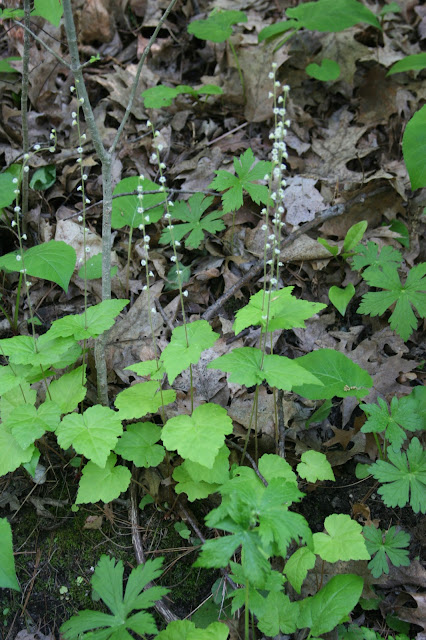One flower that demands a closer inspection is the Two-leaf Mitrewort (Mitella diphylla). The Mitrewort is named after the triangular shape of the headgear of a bishop of the Catholic Church - the mitre. The Mitrewort is alternately known as the Bishop's Cap for this reason. The Mitella in the scientific name translates to "little cap".
 |
| Close-up of the mitre-shaped fruit - photograph by Cathy Murray |
The flowers that precede the fruit are suspended on a 12 to 18 inch tall raceme above a pair of oppositely arranged simple leaves. The species name diphylla refers to these paired leaves. There is also a cluster of leaves at the base of the stem.
 |
| Two-leaf Mitrewort - note the paired leaves and small white flowers on a raceme |
Although the flowers are quite small (about 1/4 inch across) they are quite spectacular when viewed closely. Each flower has five fringed white to cream petals, 10 yellow stamen, and a pair of styles. The fringed petals give the flower the appearance of a snowflake. These flowers can be found between April and June, with most plants in Mid-Michigan blooming in May.
The Two-leaf Mitrewort can be found in wooded habitats throughout eastern North America. In the North it ranges from Minnesota in the west, through Wisconsin and Michigan, across the deciduous forests of southern Ontario and Quebec, into New England. In the South, it ranges as through the southern Appalachians into far northern Georgia and Alabama. Isolated populations are found west to Arkansas and Missouri. Although the Two-leaf Mitrewort will grow in a variety of conditions ranging from wet to dry, I typically find it in locations with moist soil, such as Beech-Sugar Maple Forests and along the edges of swamps.
The Two-leaf Mitrewort readily spreads both from seeds and by rhizomes. Colonies of the plant are often vegetative clones that spread from rhizomes.
 |
| Two-leaf Mitrewort - note the basal leaves, paired stem leaves, and flowers along racemes |
 |
| A colony of Two-leaf Mitrewort in a drier upland site with Wild Geranium (Geranium maculatum) |
Basic Information
Miterwort
Mitella
diphylla
Height: 8-18” tall
Habitat: moist to dry woodlands
Flower
Color: white to cream
Bloom
Time: April – May


No comments:
Post a Comment